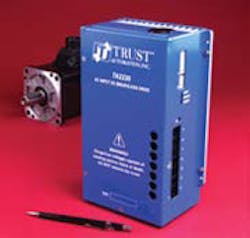The low-cost, programmable TA2230 constant-velocity drive was designed for new and existing industrial applications such as factory automation, machine tools, conveyors, injection molding machines, air compressors, pumps and existing applications where improved performance and lower operating costs are desired.
The drive runs brushless motors at constant velocities using motor Hall sensors that provide velocity feedback. Through a RS232 interface, users can program the drive at start-up to ramp up at a preset rate and maintain a constant velocity regardless of changes in load.
The TA2230 from Trust Automation Inc. (www.trustautomation.com) measures 9.3 in. by 3.5 in. by 5.7 in. Motor output from the drive with an AC supply of 100-220-V AC at 50/60 Hz, 25 Amp peak current is the equivalent of a 15,000-W (45 Amp peak) PWM drive. The DC voltage is 0-330 V AC at 45 Amp peak, 20-Amp RMS continuous.
Drive features include three speed-setting options: (Ext) external speed command via off-board 10K potentiometer, (Int) on-board potentiometer for convenient fixed speed adjustment, and (Soft) fixed speed set via software.
Other features are soft start control, integral AC line filtering, and self-contained, enclosed and optically isolated user interface for safety.
Configurable software parameters are enable input level, fault output level, coast input level, target velocity, Hall active level, and current limit.
Low Back Pressure (LBP) modular conveyors transfer parts of all shapes and sizes with minimal energy.
Parts ride on a densely populated array of plastic rollers and flow freely with low friction, exerting minimal force on adjacent parts and automation components.
Arbor Automation, part of the Orbitform Group (www.orbitform.com), integrates its LBP conveyors with machine tools, robots, operator load stations, parts washers, and virtually any production assembly systems.
The conveyors are designed for low-impact part handling with minimal part-to-part contact, work-in-process buffering/ accumulation, asynchronous or synchronous WIP flow, and lowprofile/ thin-walled/round part applications.
Easy to set up and configure, the LBP segments come in variable lengths with widths of 3.75 in. to 12 in. Features include 45 and 90 degree turns, high and low density roller spacing, multiple chain materials, and custom specified heights.
For small part conveying equipment, Balluff (www.balluff.com) has developed a mini photoelectric sensor pack that the company said puts maximum performance in a small package and helps designers reduce a machine’s overall footprint on the factory floor.
The BOS 11K sensor is part of a family that includes diffuse, retroreflective, polarized retro-reflective, and through-beam styles all within the same compact 34.5 mm by 29.3 mm by 15-mm T-style housing. Designed to be used with Balluff’s versatile BMS mounting system, the BOS 11K positions almost anywhere and at any angle.
Its threaded T-body “snout-mount” shape makes for quick installation to reduce mounting time and labor costs.
The company said the sensor’s robust ultrasonically welded IP67 housing also boasts enhanced diagnostic LEDs as well as a highly visible 360-degree LED window for easy troubleshooting.
Modular automation tooling from Piab Vacuum Products (www.piab.com) is designed to reduce compressed-air consumption by 98 percent compared with alternative air-powered venturi systems.
Shops can use the tooling to construct energy-efficient vacuum-end effector tools for a variety of general industrial and material-handling applications by combining a Coax vacuum cartridge with a Duraflex suction cup and Vacustat check valve.
This Ultimate PMAT tooling is lightweight and easy to assemble onsite without welding or using special tools, so it works well for handling materials in both the raw and finished stages of production. Ideal applications include sheetmetal stampping, die casting, injection molding, thermoforming and glass handling.
